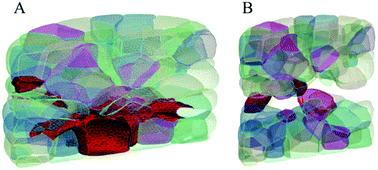Discrete element modelling of tomato tissue deformation and failure at the cellular scale†
Abstract
Bruise damage in fruit results from cell wall failure and inter-cellular separation. Despite the importance of the micro-mechanics of plant tissue with respect to its integrity, it remains largely unquantified and poorly understood, due to many difficulties during experimental characterization. In this article, a 3D micro-mechanical plant tissue model that is able to model cell rupture and inter-cellular debonding and thus provide more insight into the micro-mechanics was developed. The model is based on the discrete element method (DEM) and represents the tissue as a mass–spring system. Each plant cell is represented as a deformable visco-elastoplastic triangulated mesh under turgor pressure. To model cell wall rupture, it is assumed that a spring connection in the wall breaks at a certain critical stretch ratio and that a ruptured cell is turgorless. The inter-cellular contact model assumes brittle fracture between a cell's node and an adjacent cell's triangle when their bond distance exceeds a critical value. A high-speed tomato fruit cell compression test was simulated and the modelled force–strain curve compares well with the experimental data, including for strains above the elastic limit. By varying the shape of the cell in the compression simulation it was shown that the force–strain curve is highly dependent on the cell shape and thus parameter fitting procedures based on a spherical cell model will be inaccurate. Furthermore, the wall stiffness and thickness showed a positive linear relationship with the force at cell bursting. Besides simulating compression tests of single cells, we also simulated tensile and compression tests on small tissue specimens. Realistic tissue structures of tomato mesocarp tissue were generated by a novel method using DEM simulations of deformable cells in a shrinking cylinder. The cell area, volume and anisotropy distributions of the virtual tissue compared well with micro-CT images of real tomato mesocarp tissue (normalized root mean square error values smaller than 3%). The tissue compression and tensile test simulations demonstrated an important influence of the inter-cellular bonding energy and tissue porosity on the tissue failure characteristics and elastic modulus.



 Please wait while we load your content...
Please wait while we load your content...